The BEST way to use SEO content briefs in today's marketing landscape
Topic: Content Marketing
Published:
Written by: Bernard Huang
As a content-led SEO strategist working in this industry for nearly a decade, I’ve seen firsthand how critical it is to have a solid content creation process that balances efficiency with the time-consuming work of strategizing in-depth, high-quality content.
This balance is essential for using resources efficiently to produce successful content that ranks well on search engine results pages (SERPs) and drives organic traffic and leads.
(That’s one top reason why I’ve used Clearscope for years, even before joining the in-house team—to simplify content optimization.)
I’m going to go through our team’s process of how we use SEO content briefs in our workflow below... but a few things first:
Our organic traffic has increased by 54% since Q1 this year after putting some new processes in place and focusing on information gain and Ranch-Style SEO—despite all the changes going on in search.
There are no affiliate links or ads in this article, and I’m not going to sell you any courses or templates. I will mention Clearscope and how much I love it, and I think you should demo it for yourself. But you’ll still benefit from this article if you decide not to.
I’m not going to discuss beginner's basics here. For that, you’ll want to check out What is a content brief and why it matters for SEO.
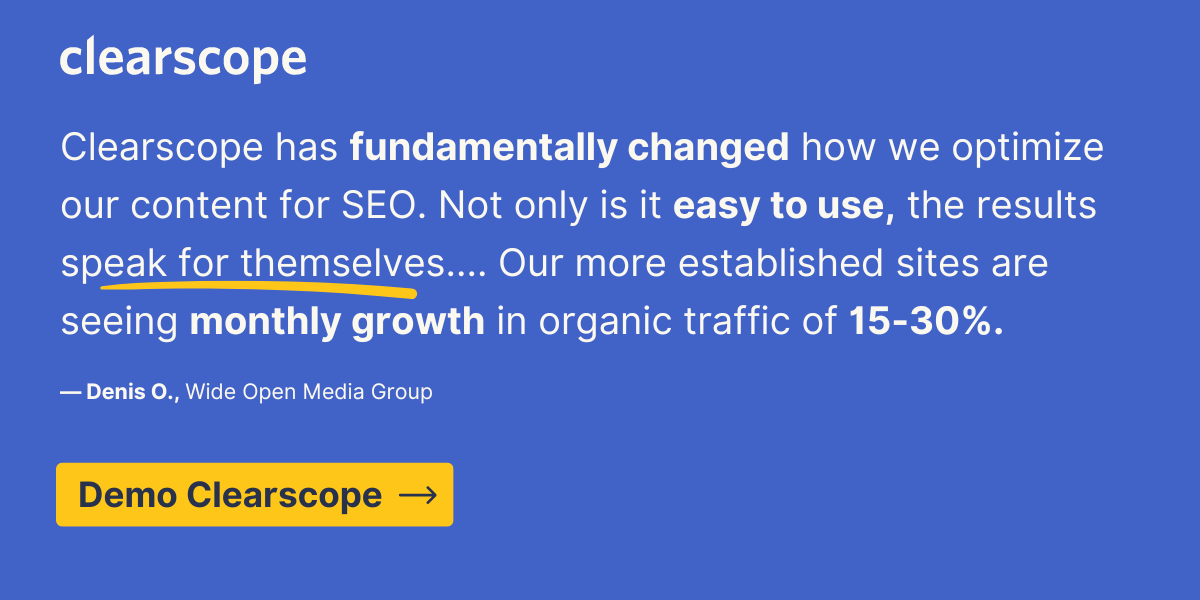
Staying organized with a smart, SEO-focused content brief has been essential to us producing all this work with a small team and growing our traffic this year.
Sure, the humble brief may seem like a one small piece of your overall content marketing or SEO strategy, but when used correctly, a good content brief can be a real workhorse.
It aligns your team of writers, ensures consistency, and guides the process from keyword research to the final call to action (CTA).
Plus, in an era of AI-generated and AI-assisted content generation, having a well-thought-out SEO brief is more essential than ever.
AI can’t fully understand your audience, their pain points, or the nuances of your brand voice.
But you and your writers do.
And while AI tools can help with writing, they lack the human touch required to craft in-depth content that resonates with searchers.
A well-crafted SEO content brief helps bridge this gap, ensuring your content speaks directly to your buyer personas and meets the needs of your target audience.
Why an SEO Content Brief matters more than ever
We’re all doing more with less these days.
It seems so many teams are looking to automate their SEO strategy, but push-button AI-generated SEO content doesn’t know your audience and what they need most.
But you, your customer, and your sales teams do.
And by collecting those details and putting them in your highly effective SEO content brief, well, look at you:
You’ll ensure your content—no matter how it’s produced—stays on target.
AI models may also struggle with recognizing gaps in competitor content. However, a strong content brief template will help your content creators, whether they’re using AI or not, produce content that fills those gaps.
Plus, when you organize and streamline a workflow, you’ll achieve more with less.
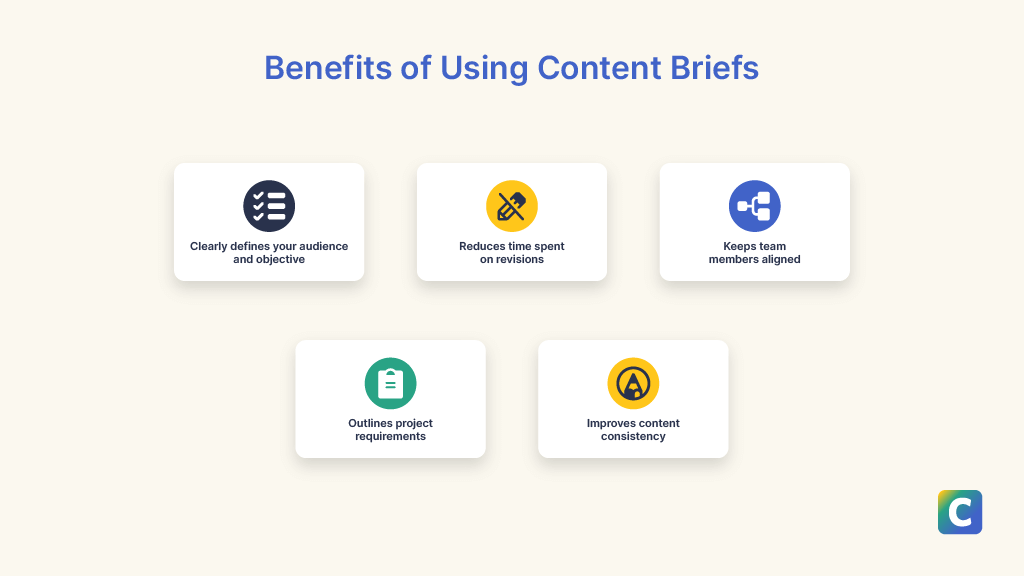
Benefits of using content briefs.
How we use content briefs in our team’s workflow
In our content production process, the brief creation phase is the starting line.
This document outlines the primary keyword, secondary keywords, search terms, and all other SEO requirements—such as directions for internal links, external links, and anchor text.
NOTE HERE: If you’re a Clearscope user, you’re usually going to target one primary search query phrase that is sharply focused on your reader’s search intent. And that search intent is what you’ll use to run your Content Draft.
If I’m sending out a brief to freelancers or subject matter experts (SMEs) who aren’t content marketers, I also include a content outline, one that features:
Headers and subheadings
Any specific subtopics that need to be covered to satisfy the true search intent of our target audience.
Additionally, I’ll map out the content format or content types, whether it's a case study, product page copy, or listicle (although many experts recognize the death of this once-popular content form, we’ve got one on AI content writing tools that’s one of our best performers).
I’ll also evaluate for true search intent ahead of assigning the brief by reviewing:
Our competitors’ meta data, like meta descriptions
The outlines of top-performing content pieces
The presence of AI Overviews or Featured snippets in the SERP
What kinds of People also ask queries pop up on the results page
And of course, our team will make notes in the brief. But the Clearscope platform makes this part super streamlined within the Content Draft.
Last but not least, in the era of AI-assisted content, if there are any custom internal GPTs that should be used or particular prompts that will serve the writer (and future readers), our team will include that in this stage.
We do all this so that the writing style and content goals are able to meet search intent from the start.
Next comes the approvals and stakeholder reviews stage.
Here, our team refines the brief, adding feedback, related keywords, internal links that help with on-page SEO, and external links from experts who are important to our audience.
The brief also serves as a roadmap for the content creators, ensuring that everyone—from freelance writers to in-house content writers—is on the same page.
The writing process follows.
Our team uses tools like Google Docs or Microsoft Word, and Clearscope, guided by the search volume and keyword research tools that informed the brief.
Because, yes, we’re Clearscope users too, we use:
The Topic Exploration tool for research
The custom brief templates within the platform
The Content Grade feature to ensure we’re sharply meeting search intent
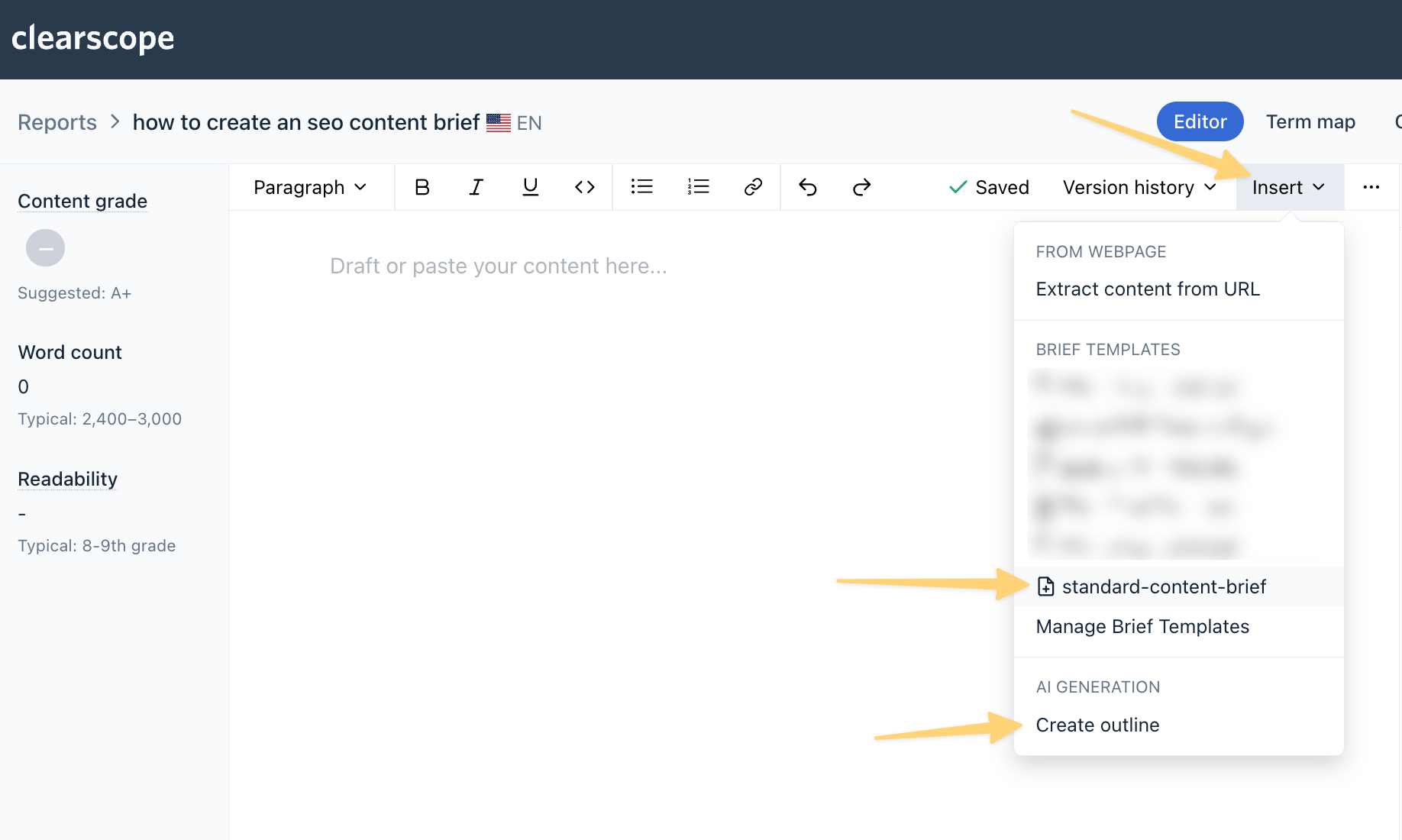
Here's where you can easily use and manage your custom content briefs and outlines within the Clearscope platform.
At this stage, we emphasize keeping the content within an ideal word count to ensure it’s digestible and meets user needs.
For us, that looks like using the least amount of words possible, following our own Ranch-style SEO principles and putting search intent and user experience first.
Once the first draft is complete, we do a second round of reviews.
Here, we’re checking the content for information gain, clarity, and alignment with the original content brief template.
Did the content meet our style guide and brand guidelines? Does it reflect the same brand voice we aim for across all platforms, including social media?
We make sure that all happens before the piece is published.
Measuring success with content briefs
After publication, Clearscope’s internal practices make sure that the content manager (that’s me!) keeps the brief for historical purposes and tracking performance metrics.
After publishing, we use the Clearscope Content Inventory to analyze how well the content is performing based on search rankings, SEO value, search engine results pages (SERPs), and organic traffic.
Over time, this data informs future rewrites and content refreshes, making it easier to adjust our content marketing strategy as needed.
By leveraging older content briefs, I can see what type of content resonated most with our audience, where I might need to optimize for different demographics or a different target user in the future, and what changes I made to a refresh that will improve our rankings.
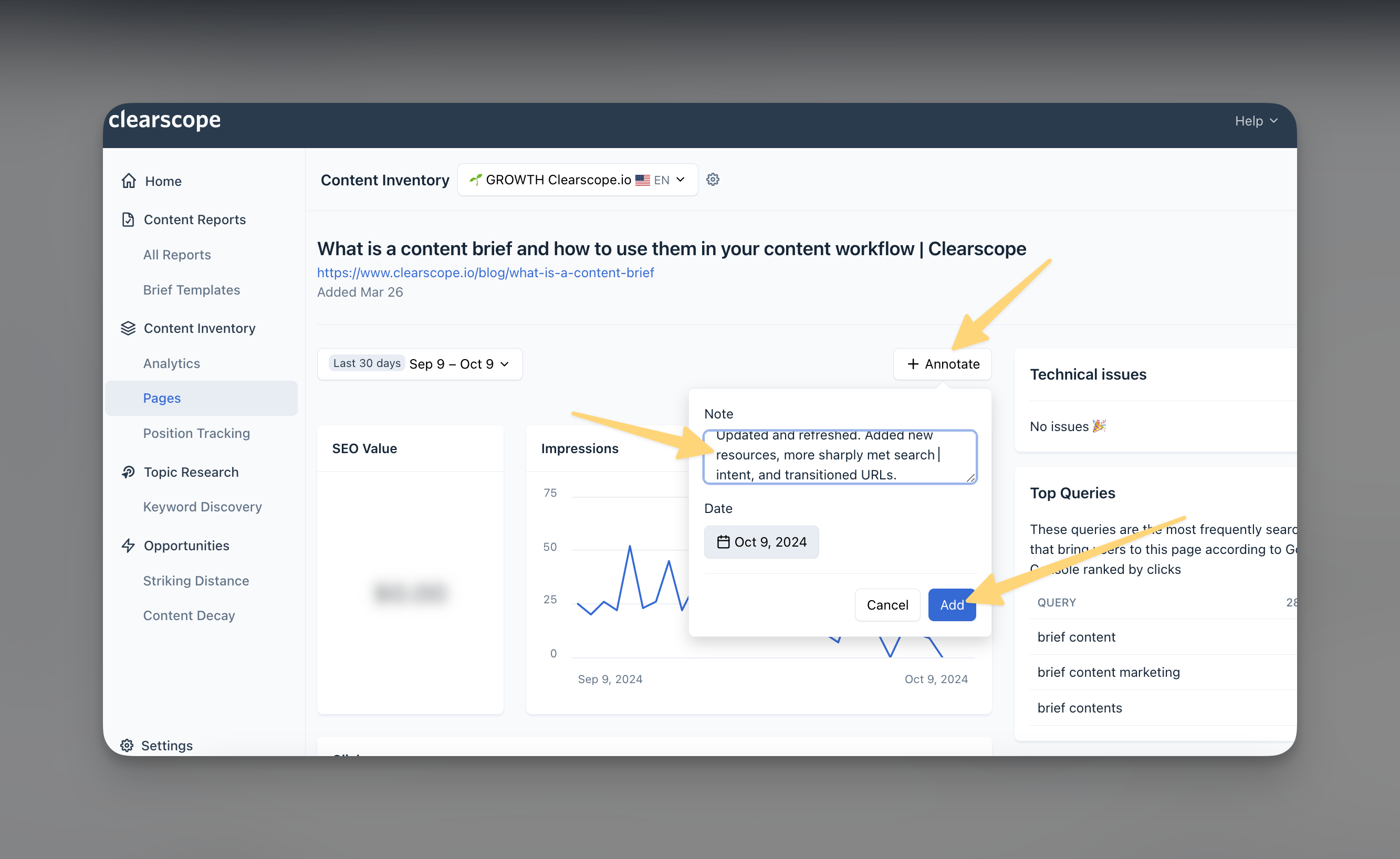
I also like to make a note of any actions taken to optimize a specific URL and note the date. That way, our whole team can see and monitor the changes in the page after this event.
This historical data also streamlines content planning for future projects, allowing us to produce the best content consistently.
Benefits of using SEO Content Briefs in the current SEO landscape
SEO content briefs are no longer just about throwing together search terms and a list of target keywords.
Today, they’re critical tools for ensuring your content hits the mark in terms of quality and SEO.
In fact, in October 2024, we asked our Clearscope LinkedIn followers about the benefits of content briefs. This group consists of digital marketing teams and SEO professionals.
Here’s what they said:
- 50% highlighted team and stakeholder alignment.
- 30% said they appreciated the clarity of objectives.
- 10% noted that briefs help reduce revisions.
- 10% emphasized consistency.
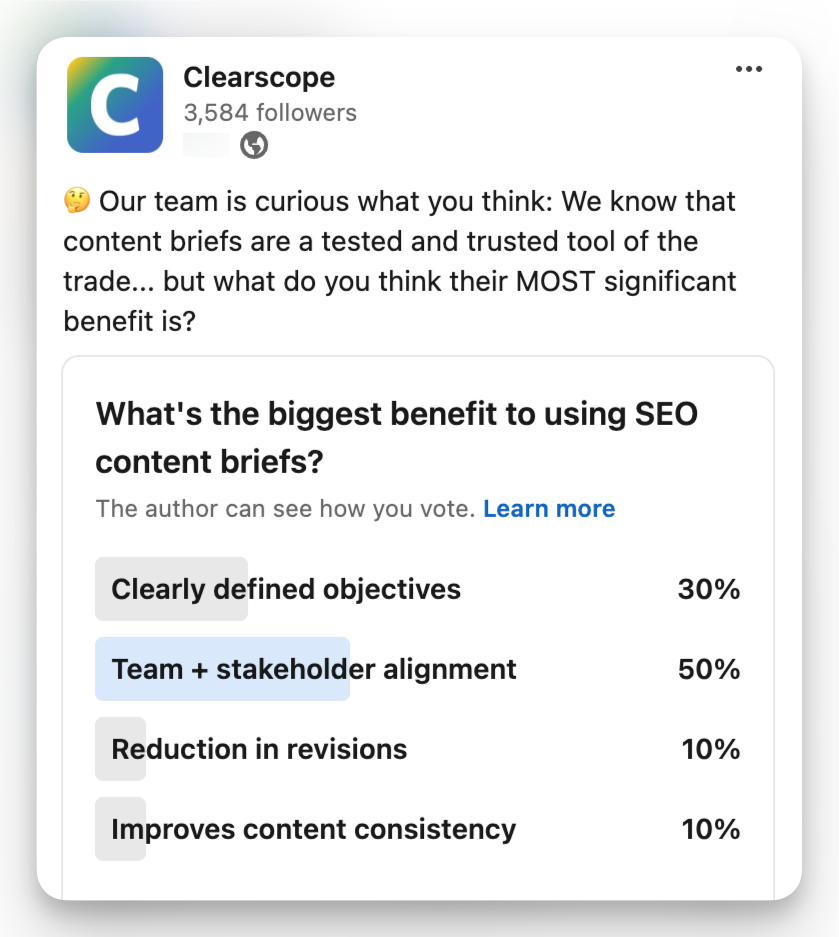
Results of Clearscope audience LinkedIn poll.
Many of the SEO marketing teams and content strategists I’ve talked to lately are striving to make better, greater content with less resourcing. That’s a huge challenge.
Don’t miss out on the benefits of streamlining the process with a detailed content brief... and don’t just fall into using a basic, cookie-cutter briefing template.
Create one that works for your team to make the best content for your audience.
1. SEO content briefs clearly define your audience and objectives
An effective content brief clarifies your buyer personas and sets clear goals for each content piece. This ensures your team of writers can produce content that meets both business objectives and audience needs.
2. Briefs reduce time spent on content production
Well-defined briefs cut down on the need for extensive rewrites and revisions, helping your content team stay efficient. Fewer miscommunications mean faster turnarounds and a smoother content workflow.
3. They work to align multiple teams and stakeholders
A strong brief aligns not only writers but also leadership, subject matter experts (SMEs), and other stakeholders.
This makes it easier to update your content marketing strategy without unnecessary surprises.
4. They’re essential to outlining key points and requirements
Use the brief as a step-by-step guide that covers everything from subheadings to CTA placement. This level of detail ensures no one is sifting through emails or messages trying to piece together what’s needed.
5. Effective content briefs can improve consistency
With a standardized SEO content brief template, you ensure that every piece of content, whether a blog, listicle, or landing page, follows a consistent format and style.
Over time, this consistency helps build trust with your audience and boosts your search rankings.
Why you need to start using SEO content briefs regularly
If you don’t regularly include them as part of your process, now’s the time to start using them in your SEO strategy.
From brand voice and copywriting to content length and on-page SEO, a comprehensive brief streamlines the entire process and improves user intent alignment.
If you're looking for a simple way to get started, a table of contents or content brief template is an excellent first step.
You can get tips on what to include (and an example of one of our in-house brief templates) in our guide on how to create the perfect SEO content brief.
By breaking down key elements, you’ll create a guide that keeps everyone aligned, from the first draft to final edits of your finalized content piece.

Contributing authors and updates
The original version of this article was published Jun 27, 2023, by Bernard Huang. It was revised on October 11, 2024, to include updated education on current best practices by Amanda Johnson from the Clearscope team.
Competitive Content Analysis: Your Step-by-Step Guide
Competitive content analysis is when you research the top-ranking content to figure out what best practices to follow to rank higher on the SERPs.
Read moreAre SEO Content Gap Analyses Overrated?
Learn what a content gap analysis is and find out if you should add it to your content marketing strategy. Discover how to do a content gap analysis.
Read more7 On-Page Optimization Tools to Create & Update Site Content
Our guide compares the best on-page optimization tools to research keywords, write SEO-optimized content, and improve rankings in Google search results.
Read more